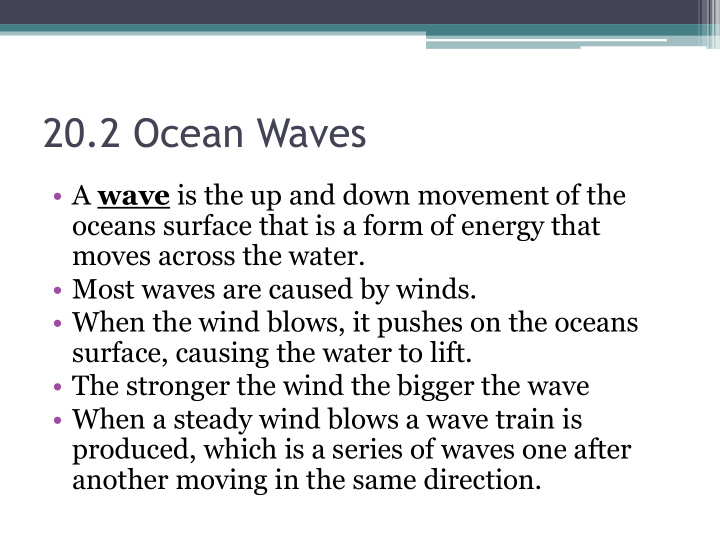



20.2 Ocean Waves • A wave is the up and down movement of the oceans surface that is a form of energy that moves across the water. • Most waves are caused by winds. • When the wind blows, it pushes on the oceans surface, causing the water to lift. • The stronger the wind the bigger the wave • When a steady wind blows a wave train is produced, which is a series of waves one after another moving in the same direction.
Wave Height and Speed • Waves are measured by the vertical distance between the top of a wave ( crest ) and bottom of the wave ( trough ) • You can calculate the speed of a wave if you know the wavelength and the period. • The wavelength is the distance between 2 crests or troughs. • The period is the time it takes a wave to pass a specific point. • Formula is Velocity (V) = Wavelength (W)/Period (P)
Waves Cont. • When waves extend beyond the windy area they generated from they have longer periods and more rounded crests. • These are called swells . • Swells can travel thousands of miles until they reach the shore where their energy is released.
What causes waves to crash? • As the wave approaches the shore it makes contact with the ocean bottom slowing the wave down. • This occurs when the waters depth is ½ the wavelength. • When the water depth is less than one half of the wavelength the top of the wave which moves faster than the bottom pitches forward and crashes.
Types of waves • Waves can also break on the open sea, strong winds produce narrow crests which are easily blown off by wind. • The mixture of air and seawater produces a white cap . This is a sure sign of bad weather. • Sometimes during a storm a rough wave occurs. These are large waves that are formed when two waves unite or when waves hit opposite currents. • These are extremely dangerous.
Tsunami’s • A tsunami is a large wave caused by an undersea earthquake. • They can reach over 100 feet in hieght and can travel as fast as 500mph • A huge Tsunami hit the southern pacific in 2005 and cause thousands of deaths.
Waves The up and down movement of the ocean’s surface A disturbance which moves through or over the surface of a fluid Mostly caused by winds (Also earthquakes, volcanoes, grav. pull) Form of great energy
Wave Characteristics Parts of a Wave Crest = high point Trough = low point Height = vertical distance from crest to trough Wavelength = Horizontal distance between crest to crest or trough to trough
Wave period (P) : time for 2 crests to pass fixed point (P) Frequency (F) : F = wavelength / P (m/s) Wave steepness : H / wavelength When H / wavelength = 1/7 or angle at crest 120 or less = Breaker
Size of Wind Generated Waves Depends on 3 things : Wind Speed Wind Duration (length of time wind blows) “Fetch” Extent of open water across which the wind can blow
Water Motion in Waves Water travels in vertical circular orbits Wave moves, particles don’t!
Importance of Waves Shaping Coastlines Erode cliffs Grind rock into sand Ecology Returns O 2 to water Stir up food for filter feeders
Types of Waves CHOP – Short period (back bays) WHITECAP – a mixture of air and water from narrow wave crests blown by wind. SWELL – Rounded crests and Long period (boat rolls; seasickness) ROGUE – Formed when 2 or more large waves from a storm unite. Tidal Bore – a solitary wave that forms when the seafloor at the mouth of the river slopes gently and the tidal range is greater than five meters. SWASH – water up beach BACKWASH – back down
TSUNAMI “TIDAL WAVE” Caused by undersea quake or volcano • Wavelength = ~150 mi. Wave height = 6” – 1’ Can NOT perceive in boat Speed > 500 mph Slows down to ~25 mph at shore; water builds up to ~65+ ft
Tsunami Waves
Creation of a Tsunami
Recommend
More recommend